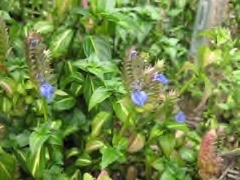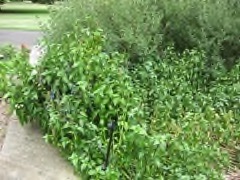 |
|
Raffi Kojian - Gardenology.org |
 |
| Raffi Kojian - Gardenology.org |
Translate this page:
Summary
Physical Characteristics

 Rungia klossii is an evergreen Perennial growing to 0.6 m (2ft) by 0.6 m (2ft in) at a medium rate.
Rungia klossii is an evergreen Perennial growing to 0.6 m (2ft) by 0.6 m (2ft in) at a medium rate.
See above for USDA hardiness. It is hardy to UK zone 10.
Suitable for: light (sandy), medium (loamy) and heavy (clay) soils. Suitable pH: mildly acid, neutral and basic (mildly alkaline) soils and can grow in very acid soils.
It can grow in semi-shade (light woodland) or no shade. It prefers dry or moist soil.
UK Hardiness Map
US Hardiness Map
Synonyms
Rungia klossii S.Moore is an unresolved name
Plant Habitats
Edible Uses
Edible Parts: Leaves Shoots
Edible Uses:
Leaves and young shoots - raw, cooked or used as a flavouring[301 , 658 ]. The leaves are often cooked together with the leaves of Setaria palmifolia[317 ]. The mushroom flavor increases with cooking (in soups or stews). After harvesting, the leaves will only keep for 2 - 3 days[658 ]. A commercially cultivated vegetable. One of the main and most popular greens in the highlands of Papua New Guinea. A nutritious plant that is higher in protein than mushrooms, it contains calcium, vitamin C, beta-carotene, iron and other vitamins and minerals.
References More on Edible Uses
Medicinal Uses
Plants For A Future can not take any responsibility for any adverse effects from the use of plants. Always seek advice from a professional before using a plant medicinally.
Vitamin C
None Known
References More on Medicinal Uses
The Bookshop: Edible Plant Books
Our Latest books on Perennial Plants For Food Forests and Permaculture Gardens in paperback or digital formats.

Edible Tropical Plants
Food Forest Plants for Hotter Conditions: 250+ Plants For Tropical Food Forests & Permaculture Gardens.
More

Edible Temperate Plants
Plants for Your Food Forest: 500 Plants for Temperate Food Forests & Permaculture Gardens.
More

More Books
PFAF have eight books available in paperback and digital formats. Browse the shop for more information.
Shop Now
Other Uses
Agroforestry Uses: It is mostly grown in mixed cropping situations with sweet potato or Setaria pitpit[658 ]. pot plant/house plant. Ornamental.
Special Uses
Food Forest
References More on Other Uses
Cultivation details
A plant of the moist tropics, where it is found mainly at elevations from 1,000 - 2,000 metres, though it can also be grown down to sea level[658 ]. It grows best in areas where annual daytime temperatures are within the range 12 - 17°c, but can tolerate 12 - 29°c[418 ]. It prefers a mean annual rainfall in the range 800 - 1,200mm, but tolerates 500 - 2,000mm[418 ]. Prefers a sunny position[418 ]. It prefers a reasonably fertile soil, preferably moist, but will grow in most soils[658 ]. Prefers a pH in the range 5.5 - 6.2, tolerating 5 - 7[418 ]. The plant grows reasonably slowly[658 ]. The shoot tips and upper leaves can be harvested from about 2 - 4 months after planting out, with harvesting continuing at 1 - 2 monthly intervals for 2 years or more[658 ]. Regular picking keeps the branches short and productive of leaves[658 ]. A commercially cultivated vegetable. One of the main and most popular greens in the highlands of Papua New Guinea. The tips are picked with 2 - 3 leaves on then, each tip weighing about 0.8g. Total yields can be 2 kg/plant/year. If the plants were spaced at 50cm spacing this would give a yield of 4 kg per square metre of garden[658 ].
References Carbon Farming Information and Carbon Sequestration Information
Temperature Converter
Type a value in the Celsius field to convert the value to Fahrenheit:
Fahrenheit:
The PFAF Bookshop
Plants For A Future have a number of books available in paperback and digital form. Book titles include Edible Plants, Edible Perennials, Edible Trees,Edible Shrubs, Woodland Gardening, and Temperate Food Forest Plants. Our new book is Food Forest Plants For Hotter Conditions (Tropical and Sub-Tropical).
Shop Now
Plant Propagation
Seed. Stem cuttings. The plant is grown from cuttings which are about 25cm long. A clump of stems are sown together - these often already have roots developing from the nodes, or very quickly develop roots. It can be planted at any time of the year[658 ].
Other Names
If available other names are mentioned here
Acanth spinach; shombay; moku; tani; kenkaba
Native Range
TROPICAL ASIA: Papua New Guinea,
Weed Potential
Right plant wrong place. We are currently updating this section.
Please note that a plant may be invasive in one area but may not in your area so it's worth checking.
None Known
Conservation Status
IUCN Red List of Threatened Plants Status :

Growth: S = slow M = medium F = fast. Soil: L = light (sandy) M = medium H = heavy (clay). pH: A = acid N = neutral B = basic (alkaline). Shade: F = full shade S = semi-shade N = no shade. Moisture: D = dry M = Moist We = wet Wa = water.
Now available:
Food Forest Plants for Mediterranean Conditions
350+ Perennial Plants For Mediterranean and Drier Food Forests and Permaculture Gardens.
[Paperback and eBook]
This is the third in Plants For A Future's series of plant guides for food forests tailored to
specific climate zones. Following volumes on temperate and tropical ecosystems, this book focuses
on species suited to Mediterranean conditions—regions with hot, dry summers and cool, wet winters,
often facing the added challenge of climate change.
Read More
Expert comment
Author
S.Moore
Botanical References
Links / References
For a list of references used on this page please go here
A special thanks to Ken Fern for some of the information used on this page.
Readers comment
| Add a comment |
|
If you have important information about this plant that may help other users please add a comment or link below. Only comments or links that are felt to be directly relevant to a plant will be included. If you think a comment/link or information contained on this page is inaccurate or misleading we would welcome your feedback at [email protected]. If you have questions about a plant please use the Forum on this website as we do not have the resources to answer questions ourselves.
* Please note: the comments by website users are not necessarily those held by PFAF and may give misleading or inaccurate information.
To leave a comment please Register or login here All comments need to be approved so will not appear immediately.
|
|